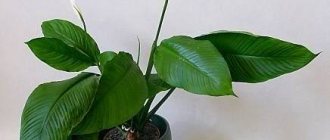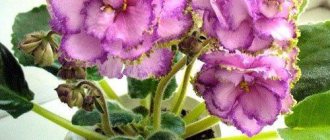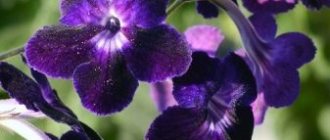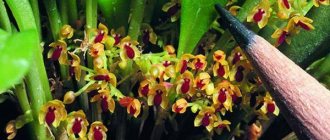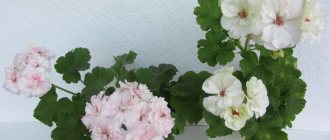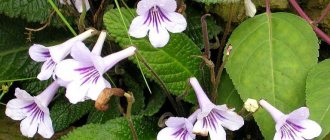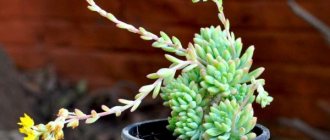Spathiphyllum is especially popular in Russia; people call it “women’s happiness.” More than 40 species and varieties of this plant are known. They belong to the Araceae family, perennial, herbaceous. Most of the specimens presented in stores are hybrids. The color of some varieties is very unusual, these include Spathiphyllum Angel Baby, Lemon Glow and others. Hobbyists collect a whole collection of these indoor plants; they fit well into the interior, have large decorative leaves, refresh the room and are easy to care for.
Spathiphyllum: about the plant
Spathiphyllum was brought to Europe in the 19th century, its homeland is Colombia and Ecuador. The first breeding of spathiphyllums was carried out by the German botanist Wallis, and one of the plant species was named after him. The name itself translates as “leaf-spread”, given because of the large wide bracts.
This evergreen plant has beautiful white cupped flowers . There are giant spathiphyllums (height reaches 1.5 meters), medium ones (up to 80 cm) and dwarfs (30-35 cm). Structure:
- roots are short;
- there is no stem, the leaves grow directly from the ground;
- leaves are oval or oblong, lancet-shaped, the central vein is clearly defined, the lateral veins are thin, the petiole is long;
- the peduncle is equal in height to the petiole or greater than it;
- the inflorescence is dense, wrapped in a blanket;
- a blanket in the shape of an ellipse, white or greenish;
- seeds are curved, sweetish.
In nature, plants choose areas near water bodies and swampy forests. Spathiphyllum is propagated by dividing the bush during spring replanting. Another option is cuttings. Seeds are rarely used for these purposes.
There is a belief connected with spathiphyllum: if on a bush , it means that the owner will soon have a new addition to her family or the appearance of a lover.
Problems, diseases and pests
Spathiphyllum is affected by diseases and harmful insects, primarily from improper care:
- The leaves dry out and turn yellow from overheating and bright sun, from poor soil and nutritional deficiency.
- Dryness, dust and low humidity cause mites. The spider mite envelops the entire bush in a web and infects the leaves.
- Because of the heat, dryness, and mustiness in the room, mealybugs appear in the axils of the leaves.
- The roots and above-ground parts turn black and rot from cold, dampness and overwatering.
- Thrips carry viruses and sooty fungus (the leaves turn black and fall off).
- The scale insect destroys petioles, peduncles and leaf blades (it is difficult to remove due to its strong shell, it is collected by hand).
- The shield aphid dries out the leaves and eats the entire bush.
- Fungi and black bacterial spot are death for Spathiphyllum; quarantine, treatment with antibacterial agents and long-term recovery are required.
- Powdery mildew with a characteristic white coating, downy mildew, chlorosis and late blight - fungal leaf spot.
Important! For the treatment and prevention of infections and viruses, modern drugs are used - fungicides, acaricides and insecticides (Aktellik, Confidor, Intavir, Marshall, Aktara, Fitoverm, etc.).
In conclusion, it must be said that Spathiphyllum is one of the most popular ornamental plants . It takes root everywhere - in apartments, offices, children's institutions, winter gardens and greenhouses. Even aquariums are decorated with lush bushes. Snow-white flowers are used in wedding floristry to decorate premises. A holiday flower, graceful and refined, will create a favorable atmosphere in any home, giving joy, happiness and peace.
Variety of species and varieties of spathiphyllum
According to the types and varieties, spathiphyllum can be divided into groups according to the table:
| Features | Unusual (differ in shape, leaf ) | Easy to care for, for beginners in floriculture | Expensive varieties | Difficult to care for | Rare | High |
| Name Spathiphyllum | Silver Rain dwarf, Domino | Angel Baby, Spilt Milk, Mauna Loa, Wallisii | Sunny Sails yellow, white, Delhi, Sensation | Spoon-shaped (Cochlearispathum), Abundantly flowering regular and mini (Floribundum, mini), Picasso (Picasso) | Lemon Glow, New One | Spoon-shaped (Cochlearispathum), New One (New One) |
The abundance of spathiphyllum varieties allows you to choose the most attractive ones in terms of color, size and labor intensity of cultivation.
Description with names and photos
Verdi
Spathiphyllum Verdi reaches a size of up to 70 cm , blooms from spring to autumn, produces many cobs, and has a white bract.
Gemini
Spathiphyllum Gemini is a variegated variety, dark green leaves with large and small gray spots, curved leaf edges. The shape of the bract is oval, the tip is pointed.
profusely blooming
Spathiphyllum floribundum has light green leaves up to 20 cm in size , the leaf surface is velvety, the central vein is light, the petiole is thin, up to 10 cm long. Peduncles up to 25-30 cm, white perianth, 4-8 cm long, about 3 cm wide. Flowering all year round.
Vivaldi
Spathiphyllum Vivaldi has an oval-shaped leaf with a clearly visible midrib. The stalk tapers towards the top. The perianth is green on the outside, white on the inside, covering the inflorescence - a light cream-colored spadix.
Quattro
Spathiphyllum Quatro variety, bred on the basis of Spathiphyllum Wallisii, up to 30 cm high, oval leaf shape, long-lasting flowering, fragrant flower. Quattro is easy to care for at home .
Pink
Pink spathiphyllums do not exist in nature, despite all the efforts of breeders. The pink color of the bedspread can be achieved by adding chemicals to the soil. The natural color of the spathiphyllum perianth is white and greenish.
Bellini
Spathiphyllum Bellini is distinguished by the presence of dense green leaves ; the petioles retain an upright position. Undemanding in care, long-lasting flowering.
Variegated
Variegated varieties of spathiphyllums are the result of the work of breeders, these include varieties such as Picasso, Domino, Dzhemeni, Haiti and many others.
Sebastiano
Spathiphyllum Sweet Sebastiano is a hybrid based on Spathiphyllum Wallisii, grows up to 70 cm tall. The leaf is glossy, with pronounced veins .
Cannofolia
Spathiphyllum Cannifolium is found naturally on the island of Trinidad, Guiana, Colombia, and Venezuela. The velvety leaves of this species are very similar to canna leaves and grow up to 50 cm long.
Does not lose its decorative effect during the period between flowering. The inflorescence is yellow-green, has a pleasant aroma, the cover is white-green. Grows well in the shade. Cannifolium requires high air humidity, but it does not tolerate waterlogging of the soil and does not like when the root system is disturbed.
Variegant
Variegated plants are variegated plants consisting of both normal cells and mutant cells that do not synthesize chlorophyll. Among the spathiphyllum hybrids with variegation, the following can be noted:
- Silver Rain dwarf - has a narrow sheet with a relief surface, a torn edge, and white strokes.
- Spathiphyllum New One with white leaf areas, does not lose brightness when shaded.
- Spathiphyllum Moon Shadow.
- Spathiphyllum Mauna Loa White.
- Spathiphyllum City of Angel.
- Spathiphyllum Angel Baby.
- Spathiphyllum Domino.
large-leaved
Spathiphyllum has large, leathery, round leaves . The height of the bush is up to 80 cm, the cover is white, the inflorescence is fragrant.
Haiti
Spathiphyllum Caiti has a small size - 30 cm, the leaf is dark green, soft, with yellow streaks, a light green stripe in the center. The cob is creamy.
Mini
Spathiphyllum mini is another dwarf species, its size is 10-12 cm. The leaves are small, with a light vein in the center, the bush is spreading.
Proper care at home is important for Mini, as the flower is capricious and requires high air humidity. Does not tolerate waterlogging of the root system.
Heliconifolia
Spathiphyllum heliconiifolium - the leaf is dark green, oblong, with a wavy edge, and has a glossy sheen. Leaf width up to 25 cm, length up to half a meter. The inflorescence is large, up to 10 cm, initially white , then darkens almost to black. The perianth is oval in shape, twice as large as the spadix. It is a large species; an adult plant reaches a height of 1 m.
Lauretta
Spathiphyllum Sweet Lauretta is a variety of Dutch selection, the original species is Wallis spathiphyllum. Sweet Lauretta has larger leaves and a higher peduncle, the spathe reaches 16 cm, grows up to 80 cm high, up to 1 m wide. The leaf is slightly wavy, with well-defined veins. Flowering occurs approximately six months after the petiole has rooted.
Mauna loa
Spathiphyllum Mauna Loa is the most common variety in home gardening . Hybrid based on Spathiphyllum floribundum. The length of the petioles reaches 10-15 cm. The leaf blade is up to 20 cm long, 5-6 cm wide, the leaf color is bright green, the shape is oblong-lanceolate with a long-pointed tip.
Peduncle up to 25 cm long, flowers collected in a spadix 3-5 cm long. The spathe is gracefully concave, white, 10-15 cm long, up to 5-6 cm wide. Absolutely unpretentious, blooms throughout the year, has proven itself in pots culture. Can be used as a cut flower and will last in a vase for about 4 weeks.
Spilt Milk
Spathiphyllum Spilt Milk is a hybrid based on Spathiphyllum blandum . Unpretentious, spectacular due to unusual leaves - the leaf is corrugated along the edge, the color of the outer side of the glossy leaf is grayish-bluish, the other side is light green, the color practically does not change depending on the light. Tolerates dry air, tolerates transplants calmly, grows quickly, reaching a height of up to 60 cm.
Mozart
Spathiphyllum Motsart forms a dwarf bush, height up to 12-15 cm, the leaf is medium-sized, dark green, oval in shape, with wavy edges.
Alfetta
Spathiphyllum Alfetta grows up to 85 cm . The leaf is oval in shape, dark green in color. The flowering period is long, the flowers are fragrant.
Mon Shadu
Spathiphyllum Moon Shadow - similar to Mauna Loa, has elongated leaves, variegated colors, yellow variegation. The bush is erect, the inflorescences are white, have a light cream tint, the plant height is up to 80 cm (more information about white spathiphyllums is described here).
The spathiphyllum flower is completely unpretentious to care for. This elegant indoor plant has many varieties that we talked about in our articles: Silver Cupido, Chopin, Sweet Chico, Alana, Sensation, Strauss, as well as red varieties.
Japanese
Spathiphyllum has bright green leaves, oval shape, wavy edge. Flowering twice a year, large inflorescences, pleasant aroma .
Among the numerous species and modern hybrids of spathiphyllums, you can choose plants of suitable sizes, interesting leaf colors and arrange your own spathiphyllum garden.
Spathiphyllum varieties with unusual leaf colors
The dense, dark green leaves of the plant do not always come in the same shade. Fancy colors attract attention against the background of other home greens and make spathiphyllum unusually beautiful. Fans of indoor floriculture are hunting for these varieties:
- Spathiphyllum Angel Baby leaves are long and thin. They have stripes of white and pale green;
- in the Domino variety, the leaf blade is covered with small light spots on a dark green background, as if paint had been splashed on the plant;
- spathiphyllum variety Lemon Glow has bright greenish-yellow leaves;
- Kaiti has soft leaves with yellowish spots;
- Gemini has large leaves with uneven inclusions in the direction of growth of the lateral veins. The bush looks unusual, because the spots are of different sizes;
- spathiphyllum variety (Spilt Milk) has matte leaves that are pale green, almost white;
- unusual oblong leaves of City of Angel spathiphyllum are almost white, with green speckles;
- Due to low demand, the Picasso variety was temporarily stopped exporting. The color of the plant is similar to the landscapes of the artist in whose honor it was named: in one area the dark green leaf is covered with small, thin light strokes, in the other large white and green spots alternate. The flower's veil also has a heterogeneous green-white color;
- The leaf blades of Spathiphyllum Black Beauty have a dark, rich green, almost black color.
Plants of this genus are mostly unpretentious, but there are growing nuances that must be taken into account.
What groups of plants are there?
Unusual
This group includes the following varieties:
- Spathiphyllum Cochlearispathum;
- Chopin;
- Spathiphyllum heliconifolia.
Easy to care for
These varieties include:
Expensive and rare
As a rule, rare plant varieties are considered expensive, which include:
- Lemon-Glow;
- Cannifolium-Sunny-Sail;
- Spilt-Milk;
- Spathiphyllum-cannifolium-Black-Beauty;
- Angel baby.
The most difficult to care for
Some of the most fastidious, but no less beautiful, are the following species:
- Cupido;
- Spathiphyllum Floribundum mini.
Large
You can grow giant spathiphyllum at home if you choose the following species:
How to care for spathiphyllum
The flower loves warmth, it does not have a rest period, so it is necessary to maintain the temperature regime all year round. In winter it is at least 16 degrees. The plant is native to the tropics and is accustomed to a humid and sunny climate. You will need a lot of light; it is advisable to keep spathiphyllum on an open windowsill. Periodically, the pot needs to be rotated around its axis so that the leaves do not tilt toward the ultraviolet source. If there is not enough light, the plant will not bloom.
If the flowers have faded, they must be removed, and the same is done with old leaves. Periodically wipe the plant with a damp cloth.
To make spathiphyllum feel comfortable, it is planted in a mixture of:
- peat;
- leaf humus;
- river sand or perlite;
- pieces of pine bark;
- charcoal.
Problems during cultivation
How to care for peperomia at home
Let's look at the most common problems that can arise with a plant and describe methods for dealing with them.
Leaf color change
If the plant turns yellow, then most likely the conditions of its maintenance are violated. This can be either insufficient watering or low relative humidity, or the consequences of sunburn.
Dealing with all these reasons is simple: they need to be eliminated. Place the plant in partial shade, water regularly and spray it.
If the leaves turn yellow, the plant may not be getting enough moisture.
If blackening of the leaves is observed, this indicates that the plant’s root system is dying. Most likely, the opposite is the case here: excess moisture, leading to stagnation in the root system.
In this case, urgent measures need to be taken.
First of all, it is necessary to remove the plant from the pot and find out the reason why the moisture stagnates. Most likely, you will have to redo the drainage system in the pot.
Blackening of leaves
After this, it is necessary to remove all rotten roots, prepare a new substrate and transplant the plant into a pot with an updated drainage system. This is followed by the standard procedure for reducing watering and treating the plant with epin, described earlier.
The soil should be slightly acidic.
Feed the flower with special fertilizers every 14 days. In winter, this can be neglected, since spathiphyllum grows more slowly.
Air humidity should be high, so use a humidifier and spray the leaves with water when watering. Watering is required infrequently, 1-2 times a week; there is a high risk of flooding the plant, especially in the winter months. Spathiphyllum does not tolerate drafts.
The bush needs to be replanted once every 2 years, but it can be propagated by division. It is carried out in the spring, without waiting for the flowers to appear. If the roots have not grown and the plant does not feel discomfort, then the procedure can be postponed. Rules for replanting a plant:
- The spathiphyllum pot must have drainage holes.
- Drainage should be poured into the bottom (expanded clay, broken brick or clay shards).
- Sprinkle with a small amount of substrate.
- Spread the roots of the flower and place in the center of the pot, sprinkle with soil.
- Fill the pot completely and press the soil a little with your fingers; there should be 1-2 cm left to the edge of the pot.
After transplanting, place the flower in a dark place and do not water it for 3-4 days.
Features of home care
- The main thing to remember is that Spathiphyllum needs a soft, humid, warm microclimate.
- Cold, dampness, temperature changes are death for the plant.
- Also, bright sun, dryness, mustiness, and heat are contraindicated for it.
- The optimal temperature is 20-220C all year round.
- In summer, water procedures are required - daily spraying, immersion, humidification of the room, warm shower.
- In winter, watering is moderate, the roots should not get wet.
- During the active phase and after flowering, once every 3-4 weeks it is necessary to feed Spathiphyllum with mineral and organic fertilizers, feeding alternates.
- Replanting, pruning and dividing the bush is carried out every year.
Reproduction
Growing Women's Happiness is a pleasure - the flower grows quickly and forms young rosettes abundantly . The “babies” are usually separated during the annual spring transplant.
Important! In order for the shoot to take root quickly, 2-3 young rosettes with a sufficient part of the developed rhizome are planted at once.
Adult bushes are also propagated by dividing the rhizomes during transplantation.
The procedure is simple:
- Carefully remove the mother bush from the pot.
- Pre-soak the earthen ball by immersing the pot in a bucket of water.
- The roots are untangled and an incision is made with pruning shears at the common attachment point.
- Rotten and dry shoots of the rhizome are cut off, and the sections are sprinkled with an antiseptic (crushed coal).
- Each plot is planted in a separate container.
To speed up the establishment, the seedling after transplantation is covered “head over heels” with a transparent plastic film for 5-6 days, watering is replaced with copious spraying for a week.
Transfer rules
- Flower growers recommend replanting home bushes every year in the spring, after flowering.
- Purchased specimens are replanted after 10-12 days (the substrate is completely changed, the planting container is selected according to size, the bush is treated with insecticides and fungicides to prevent infection).
- Adult bushes require division and replanting at intervals of 2-3 years (no more).
Attention! An overgrown old bush does not bloom and does not produce offspring, the root system grows, it does not have enough space (the shoots make their way through the drainage holes).
Transplant procedure:
- Prepare a loose, light, slightly acidified substrate in advance.
- The composition of the mixture is turf soil, leaf humus, sand, sphagnum moss. For looseness, add red brick crumbs, perlite, and pieces of foam plastic.
- Add 2 granules of microfertilizer, 1 tbsp to the finished earth mixture. l. superphosphate and wood ash (can be replaced with bone meal) for nutritional value.
- The pots and mixture must be disinfected, and the instruments must be wiped with alcohol.
- Drainage is poured onto the bottom (clay shards, pebbles, pieces of expanded clay or polystyrene foam).
- Take the bush out of the pot, remove all dried fragments, if there is rot, cut out completely affected shoots and leaves.
- The bush is transferred from the previous container to a new one, preserving the integrity of the earthen coma (the transfer method does not injure the roots, Spathiphyllum will quickly master the new space).
- The space of the pot is filled with a new substrate, the soil is lightly compacted (so that there is no air cushion).
- Spray daily, water moderately along the edge of the pot or through a tray (the mixture is moistened before planting).
How to choose the right soil
The soil for spathiphyllum needs to be light and loose. It should be moisture- and breathable with a slightly acidic reaction (pH 5 - 6.5). The soil mixture includes leaf, coniferous and turf soil, as well as peat, humus and coarse river sand in approximately equal parts. You can also add a little charcoal, crushed tree bark (or coconut fiber), superphosphate and broken red brick to the soil. The share of all additives should not exceed 10%.
Many gardeners use a ready-made mixture for plants of the Araceae family or for blooming tropical flowers. It is advisable to add a little (half a glass per pot) of river sand to the purchased composition.
At the bottom of the pot you must put a layer of drainage material (fine expanded clay, small pieces of red brick, pebbles).
The legend of women's happiness
The modified white leaf, gently enveloping the inflorescence spadix, is very similar to a wedding veil. This is probably why spathiphyllum is called “women’s happiness.” It is considered good form to give it to young girls of marriageable age. It is believed that its energy strengthens love and even helps in choosing a life partner.
Legend has it that spathiphyllum begins to bloom on the eve of pleasant changes on the “personal front”. Be that as it may, admiring delicate “palm” flowers really gives joy and inspiration, therefore this flower has the right place in our apartments and houses!
So, there’s a new addition to the home collection of indoor plants. When the first joy of the addition subsides, thoughts begin to swarm in your head, the main one of which is “how to care for”?
Flowers in stores are sold in shipping containers filled with a light inert substrate. Any plant from it, and especially spathiphyllum, must be replanted. This should be done 2-3 weeks after delivery home.
Possible problems during cultivation
Many gardeners cannot understand why spathiphyllum does not bloom. The plant may lack nutrients. It is recommended to apply fertilizer. If the flower has not been replanted for a long time, the soil in the pot could become poor. The plant must be replanted as quickly as possible. The lack of flowers may be due to the large volume of the pot. Spathiphyllum does not enter the flowering period until its roots have “mastered” the entire space of the container.
Black and brown tips on the leaves indicate overwatering at low temperatures or too much fertilizer.
Foliage withers in the absence of watering or in the event of a sharp temperature change.
By the dry and yellow tips of the leaves, you can understand that the air in the room is very dry. They can also be a sign of a lack or excess of nutrients.
Spathiphyllum grows slowly in the shade and with plenty of moisture. Pests attack a weakened plant that lacks nutrients and light.
Transplantation, propagation and care
Like all living beings, a flower needs to be transplanted. A larger pot is an appropriate and good option. For replanting, choose dishes that are not too large. This may lead to the fact that the owner does not wait for the flowering period at all.
Take a look at the rhizome of the plant; when choosing a pot, you need to focus on it. The pot itself should be only a few centimeters larger than the root. Replanting is best done in the spring. And remember that for this type of flower, appropriate soil is needed. It could be:
- Sod land.
- Sand.
- Peat.
- Humus.
Reproduction is best done by dividing the bush into two parts. This will not only strengthen the vital abilities of the green miracle, but will also give rapid flowering. Have you noticed that spathiphyllum quickly develops and blooms? This is a very good sign. This is a sign that in the near future the owner of the flower will not be spared by female happiness.
Diagnosis by leaves
Women's happiness belongs to the group of green flowers, the state of which can be easily determined by the stems and leaves. Some changes in appearance will signal an impending disease.
- Have you noticed brown spots on the leaves? This is a signal of an excess of minerals. Stop feeding the flower for a while.
- Are the leaves turning yellow and then falling off? An excess of water makes itself felt.
- Monitor the temperature. Sudden changes can lead to the fact that the green miracle will die altogether.
- Do the petioles stretch and stretch at the top? There is not enough lighting. Move the pot to a brighter place. But remember to avoid direct sunlight.
- Are the leaves withering? This indicates two signs of improper care at once. Lack and excess of moisture make themselves felt.
- Be very careful when replanting. Damaged roots can cause the trunk to dry out.
- Did you notice that it was the tips of the leaves that began to turn black and dry out? As we found out, this is a tropical green and it needs water. This phenomenon indicates insufficient air humidity. Moisturize the green miracle.
- Are young leaves not fully unfurling? It's about the soil. Check it out. If it is very compacted, it is necessary to fluff it up using special tools.
- Did you have to remove a few rotten roots during the replanting process? For the first three days, forget about watering. This will only make the growth process worse. Use a spray bottle.
- Has women's happiness not bloomed for a long time? This indicates an incorrectly selected pot. Replace it with smaller, more compact dishes. We remind you that it must be placed in a place with sufficient lighting.
- Have you noticed that the green beauty is too frail? This is the first sign about transplanting and feeding. In a special store, select food for flowering plants. It will strengthen the immune system and women's happiness will bloom on a magnificent scale.
Care is very simple. Don't forget the important parts of this process. Decorating the interior and comfort of your home has become much easier. Create your own green, indoor greenhouse.
